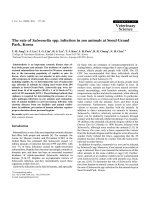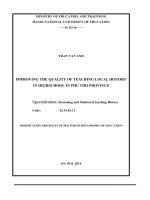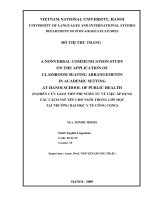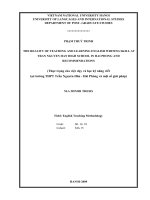The steps of teaching model sentences in grade 4 at thach dong primary school
Bạn đang xem bản rút gọn của tài liệu. Xem và tải ngay bản đầy đủ của tài liệu tại đây (548.48 KB, 17 trang )
THACH THANH DEPARMENT OF EDUCATION AND TRAINING
THACH DONG PRIMARY SCHOOL
Initiatives experience’s name :
THE STEPS OF TEACHING MODEL SENTENCES IN GRADE 4
AT THACH DONG PRIMARY SCHOOL
Teacher’s name
Duty
School
Subject
: Mai Thị Hường
: Teacher
: Thạch Đồng Primary school
: English
Thach Thanh, 2018
1
CONTENTS
1. THE MAIN
1.1 Reasons for selecting the topic.
1.2 Purpose of the study.
1.3. Research subjects.
1.4. Research methods.
2. CONTENT
2.1. Basis for argument.
2.2. Current status of teaching and learning English in Thach Dong
Primary School.
2.3. The solutions used to solve the problem.
2.3.1. Introduce new words or phrases in the lesson.
2.3.2. Practice listening and practicing the conversation in the lesson.
(Part 1. Look, listen and repeat)
2.3.3. Introduce model sentences.
2.3.4. Practice model sentences. (Section 2. Point and say)
2.3.5. Game activity to deepen the sentences learned.
2.3.6. Some examples of demonstration classes have been applied
effectively in grades 4.
2.4. Results.
2.4.1. For educational activities.
2.4.2. For teachers.
2.4.3. To colleagues.
2.4.4. For the school.
3. CONCLUSIONS AND RECOMMENDATIONS
3.1. Conclusion.
3.2. Petition.
- REFERENCES
- THE INITIATIVES EXPERIENCE HAS BEEN CLASSIFIED
3
3
3
3
3
4
4
4
5
5
6
6
6
6
7
14
14
14
14
14
14
14
15
17
18
1. THE MAIN
1.1 Reasons for selecting the topic.
Our country is in the process of developing the knowledge economy as the
foundation for development and consider education and training as the top national
policy and improve the quality of teaching and learning to successfully complete the
training. human resources for industrialization and modernization of the country. In
order to survive and develop our nation's construction and defense to keep pace with
the developed countries, we need to capture the most advanced achievements. Aiming
to make Vietnam a civilized and prosperous country.
Today, according to the development trend of the times, English gradually became the
common language in many fields in social life. English helps us to access more
2
effectively with the rich source of human knowledge to integrate with other countries
in the world. Therefore, learning English has become more important than ever. In
recent years, English has been taught in popular schools. And there are many small
and large research projects on English teaching and learning, aiming to find effective
teaching and learning methods. For effective teaching and learning in the primary
school walls, I am the person who directly teaches many questions about how to help
elementary school students access to a new language. Wanting to learn and
communicate well in English requires students to have a certain vocabulary, and
students need to master the sentence structure with grammatical functions, usage,
reading and meaning. To help them speak English smoothly, coherently and above all
to help them become more confident in communicating and absorbing the language. I
would like to give you some reference experiences on how to guide students to learn
the grammatical structure that I have accumulated in the process of learning and
teaching. That's why I chose the topic 'The steps of teaching model sentences in grade
4 at Thach Dong primary school’.
1.2 Purpose of the study.
- Learn about solutions for improving English teaching and learning for teachers and
students.
- Learn about the student's learning situation.
- Study the optimal methods for teachers to apply when students practice in the
classroom effectively.
- The steps for effective teaching are changed by changing some of the methods that
teach students to easily learn the lesson. At the same time instruct students to train
themselves to have skills, skills when learning English.
Therefore, the implementation of this method aims to promote students' activeness,
initiative and creativity, contributing to improving the quality of teaching English.
1.3. Research subjects.
- Students in grades 4A, 4B in Thach Dong Primary School.
1.4. Research methods.
- Application of practical teaching experience.
- Refer to the practice materials related to the subject
- Refer to the experience of colleagues, attendance, exchange ideas.
- Organize and conduct experiential teaching. Prepare teaching curriculum to test the
feasibility of the method.
- The teacher asks questions to check the content of the student's lesson.
2. CONTENT
2.1. Basis for argument.
At present, the teaching and learning of foreign languages in primary schools
has been markedly improved. Elementary school children, including schools in
remote areas, are taught foreign languages. Teachers are regularly trained to improve
their professional skills and innovate teaching methods to improve the quality of the
3
subject. In all schools, materials and teaching materials are increasingly being added
to make learning more effective and students are more interested in learning.
However, due to the student's unevenness. The foreign language environment
of the children rarely have the opportunity to talk with foreigners. The development of
communication skills in children is limited.
Moreover, the current situation of learning neglect, students learn coping, rote
learning without self-study, students are quite a lot. Most of the students do not pay
attention and invest in English, preparing the paper skilfully, coping while they study
very weak subject.
How does another condition this condition? How to attract students to focus on
learning is an issue that requires educators, dedicated teachers who work hard to come
up with plans, programs that improve the way they teach and learn. more, improve the
quality and effectiveness of education.
To teach an English language class requires teachers to be prepared and
invested both at home and in the classroom, even having to accumulate experience
over time can be effective and persuasive. , making them really excited and confident.
Therefore, with this topic, I would like to express my thoughts and my wishes with
the desire to contribute to the exchange of experiences and sharing of learning
together for the same progress.
2.2. Current status of teaching and learning English in Thach Dong Primary
School.
* Advantages:
- English is a new discipline applied to elementary students in recent years. So some
students feel excited or interested in this new subject, so in most classes most students
are very active.
- Having the interest of the school's board, together with the siblings in front of them,
makes the teaching of English better. The school has had almost adequate facilities,
materials and equipment to serve teaching and learning.
* Disadvantages:
According to the distribution of the current program, English elementary school
has 4 lessons per week, so it is really hard to teach the teacher and the students. But in
order for students to become more active, teachers must prepare their pictures and
tools to draw their attention to the topic or focus of the lesson. In addition, there are
many students here because of conditions and circumstances, parents do not
understand the importance of English so not interested, urge the children to study this
subject, many to sue there. complete study materials. In addition, due to the limited
development conditions, the conditions for elementary school children to be exposed
to public information and entertainment programs using English is still low. Their
ability to communicate is limited, especially in English.
- Beside some students studying seriously, there are many pupils who learn
only through loudspeaker, not in deep memory, do not practice reading and writing
frequently, do not have two-dimensional sense. When the teacher asks them not to.
4
Moreover, very few people in the family are learning, knowing English should check
and guide the children to learn at home also meet many difficulties.
* The results of the 4th English language course of the school year 2016-2017
Class Quantity
Finished well
Finish
Unfinished
Quantity
Ratio
Quantity
Ratio
Quantity
Ratio
4A
23
3
13 %
20
87%
0
0%
4B
24
5
20,8%
19
79,2%
0
0%
2.3. The solutions used to solve the problem.
To help students master the English sentence form is very important in the
teaching process, so teachers need to find appropriate teaching methods in the process
of forming students' knowledge, especially in the Sample sentences with new
grammar structures
As a teacher teaching English, I myself have tried to find the main solutions to
help students master the sentence after the lesson. Here are some of the solutions that
I myself have applied in the course of teaching:
2.3.1. Introduce new words or phrases in the lesson.
Introduce new words or phrases in the lesson through pictures or explanations
so they find new words or phrases.
- Teachers write each word or phrase on the board, asking the students to write in their
notebooks.
Ask the children to read new words or phrases in their own language, in groups, and
in their class.
- After introducing all the new words or phrases in the class, the teacher asks the class
to re-read the entire word or phrase.
- Have some students read individually and ask some of them to say the new
Vietnamese words or phrases.
- Choose one of the small games such as: What and where, Rub out and remember,
Slap the board, Matching ... to check the level of awareness and remember the new
words and phrases that they have just been acquainted.
2.3.2. Practice listening and practicing the conversation in the lesson. (Part 1.
Look, listen and repeat)
- Introduce students to the conversation they will listen to and practice.
- Before you listen, ask the students to look at the contents of the dialogue through the
pictures contained in the dialogue by asking small questions related to the character in
the pictures, the action of the characters, the place in the paintings.
- Have the students listen to the conversation twice.
- Tell the students to repeat the tape twice.
- Let them work in groups to play the characters and reread the dialogue.
- Give 2 or 3 groups practice the conversation in front of the class.
- Ask the children to rehearse the conversation.
5
- Check their understanding of the content of the conversation they practice.
2.3.3. Introduce model sentences.
- From the content of the conversation they have practiced the teacher to ask questions
to the students to find the model sentences of the lesson.
- Have students write the model sentences in their notebooks.
- Explain to students how to replace words or phrases in the model sentences so they
can use them with other words or phrases.
- Allow students to practice reading the model sentences individually, in the same tone
and role-plays.
- For example, let students engrave using model sentences with other words and
phrases.
- Let students reread the example.
2.3.4. Practice model sentences. (Section 2. Point and say)
- Use pictures with suggested words or phrases, asking students to use model
sentences to practice with these pictures.
- Ask students to work in pairs or groups to practice.
- Give a pair or group a pattern.
- Ask the whole class to practice in a certain time.
- Give some practice groups to the class.
- Have the students read the same sentences again.
- Ask students to find situations, real data based on knowledge, knowledge they have
learned, use sentence patterns to practice.
- Ask them to work in pairs or groups. The teacher observes and assists the student if
they need help.
- Give some practice groups to the class. For comment groups, teachers commented
and corrected the children.
2.3.5. Game activity to deepen the sentences learned.
- The teacher designed one of the games such as Lucky number, Whisper, Matching,
Word cue drill ... for students to help students to deepen their learning.
- Before playing the instructor how to play, the rules of the game.
- Organize the test.
- Teachers divide the teams.
- Have students play the game.
- Announces the results of the game, recognizes the results of the teams, announces
the winner and motivates them.
2.3.6. Some examples of demonstration classes have been applied effectively in
grades 4.
* Example 1: Unit 5. Can you swim? Lesson 1. 1-2.
6
- The goal of the unit is to introduce students
+ Words like can, draw, dance, sing, skip, skate, cook, swim.
+ Model sentences: What can you do? - I can ...
a. Introduce new words.
- Use pictures, explanations and actions to introduce the words: can, draw, dance,
sing, skip, skate, cook, swim.
- Ask the students to copy the words into their notebooks.
- Practice students to read bilingual, group and individual words.
- Have students play What and where games to bring up the words they have just been
introduced to.
7
b. Practice conversation.
- Ask the students to look at the pictures a, b, c, d in part 1 and answer the questions:
+ Who are they? (Mai, Nam and Phong)
+ Where are you? ( In the school yard)
+ What are you doing? (Mai Cat Painting, Phong dance, Nam singing)
- Let the students listen to the tape twice.
- Ask them to repeat the tape twice.
Ask students to work in groups of 3 as three characters and practice reading the
conversation again.
- Ask two groups to read in front of the class.
c. Introduce model sentences.
- The teacher gives an open question to students to find out the model sentence:
+ What did Nam ask Phong?
(What can you do, Phong?)
+ How did Phong respond to Nam? (I can dance.)
- Teachers write model sentences on the board, asking students to write in their
notebooks.
What can you do?
I can dance
- The teacher explained: It is possible to change only the words that you can do in
underlined words to talk about your ability.
- Ask the students to reread the model sentences, in pairs.
- Ask for examples.
- Ask the students to read in pairs, for example.
d. Practice model sentences.
- Ask students to observe 4 pictures a, b, c, d in section 2 with suggested words.
- Ask the students to work in pairs, use the above form to practice asking and
answering with the suggestions in the pictures.
- Have 2 students practice the model sentence in front of the class.
- Ask them to practice in 2 minutes. The teacher keeps track of and helps.
- Give 4 groups to practice in front of the class.
- Ask the students to comment, the teacher commented and corrected the mistake.
- Ask the students to read the complete sentences.
- Continue to ask students to work in pairs, ask and answer about the same activities
they can do.
- Give the students 2 samples.
- Ask all pairs to practice in 2 minutes. Teachers follow and help.
- Ask the groups to practice in front of the class.
- Students comment, teachers comment and correct mistakes.
e. Game activity.
- Teachers organize students to play Lucky number games.
1. skip
2. lucky number
3. skate
8
4. Lucky number 5. cook
6. swim
- Teachers how to play and rules.
- Divide the class into 2 teams.
- Have students to play.
- Organize two teams to play the game.
- Announced the results of two teams play. Praise the children.
* Example 2: Unit 7. What do you like doing? Lesson 2. 1-2-3
- The goal of the unit is to introduce students
+ Words like: hobby, riding a bike, playing badminton, flying a kite, taking photos,
watching TV, playing the piano.
+ Model sentences: What's your hobby? - I like ............
a. Introduce new words.
9
- Use pictures, explanations and actions to introduce them to the words: hobby, riding
a bike, playing badminton, flying a kite, taking photos, watching TV, playing the
piano.
- Ask the students to copy the words into their notebooks.
- Practice students to read bilingual, group and individual words.
- Have students play Rub out and remember to deepen the words they have just been
acquainted with.
b. Practice conversation.
- Ask the students to look at the pictures a, b, c, in part 1 and answer the questions:
+ Who are they? (Phong, Tony, Mai and Linda)
+ Where are you? (In front of music club)
+ What are you doing? (talk about music)
- Let the students listen to the tape twice.
- Ask them to repeat the tape twice.
- Ask students to work in groups of 4 as three characters and practice reading the
conversation again.
- Ask two groups to read in front of the class.
c. Introduce model sentences.
- The teacher gives an open question to students to find out the model sentences:
+ What did Phong ask Linda?
(What's your hobby, Linda?)
+ How did Linda respond? (I like playing the piano.)
- Teachers write model sentences on the board, asking students to write in their
notebooks.
What's your hobby?
I like playing the piano.
- The teacher explained: It is possible to change only words that you like doing in
underlined words to talk about your hobbies.
- Ask the students to reread the model sentences, in pairs.
- Ask for examples.
- Ask the students to read in pairs, for example.
d. Practice model sentences.
- Ask the students to observe 5 pictures a, b, c, d, e in section 2 with suggested words.
- Ask the students to work in pairs, use the above form to practice asking and
answering with the suggestions in the pictures.
- Have 2 students practice the sample in front of the class.
- Ask them to practice in 2 minutes. The teacher keeps track of and helps.
- Give 4 groups to practice in front of the class.
- Ask the students to comment, the teacher commented and corrected the mistake.
- Ask the students to read the complete sentences.
- Continue to ask students to work in pairs, asking and answering about the activities
they like to do or their own interests.
10
- Give the students 2 samples.
- Ask all pairs to practice in 2 minutes. Teachers follow and help.
- Ask the groups to practice in front of the class.
- Students comment, teachers comment and correct mistakes.
e. Game activity.
- Teachers organize students to play the Whisper game.
1.What's your hobby?
2. I like playing chess.
3. What do you like doing?
4. I like taking photos.
5. I like collecting stamps.
6. I like riding a bike.
- Teachers tell how to play and rules of game.
- Divide the class into 2 teams.
- Have students to play.
- Organize two teams to play the game.
- Announced the results of two teams play. Praise the children.
* Example 3: Unit 16. Let's go to the bookshop. Lesson 2.1-2-3
11
- The goal of the unit is to introduce students
+ Words like: cinema, swimming pool, see the animals, see a movie, buy something
to eat.
+ Model sentences: Why do you want to go to the ......?
Because I want to ................
a. Introduce new words.
- Use pictures, explanations and actions to introduce them to the words: cinema,
swimming pool, see the animals, see a movie, buy something to eat.
- Ask the students to copy the words into their notebooks.
- Practice students to read bilingual, group and individual words.
- Have students to play What and where games to bring up the words they have just
been introduced to.
b. Practice conversation.
- Ask the students to look at the pictures a, b, c, d in part 1 and answer the questions:
+ Who are they? (Mai, Tony and Linda)
+ Where are you? (Outside the school gate)
+ Where are you going? (You are coming to the supermarket.)
- Let the students listen to the tape twice.
- Ask them to repeat the tape twice.
- Ask students to work in groups of 3 as three characters and practice reading the
conversation again.
- Ask two groups to read in front of the class.
c. Introduce model sentences.
- The teacher gives an open question to students to find out the model sentences:
12
+ What did Tony ask Mai?
Why do you want to go to the supermarket?
+ How did Mai respond? (Because I want to buy something to eat.)
- Teachers write model sentences on the board, asking students to write in their
notebooks.
Why do you want to go to the supermarket?
Because I want to buy something to eat.
- The teacher explained: It is possible to change only words that you can do in the
underlined words to ask and answer the reason for wanting to a place.
- Ask the students to reread the model sentences, in pairs.
- Ask for examples.
- Ask the students to read in pairs, for example.
d. Practice model sentences.
- Ask students to observe 4 pictures a, b, c, d in section 2 with suggested words.
- Ask the students to work in pairs, use the above form to practice asking and
answering with the suggestions in the pictures.
- Have 2 students to practice the sample in front of the class.
- Ask them to practice in 2 minutes. The teacher keeps track of and helps.
- Give 4 groups to practice in front of the class.
- Ask the students to comment, the teacher commented and corrected the mistake.
- Ask the students to read the complete sentences.
- Continue to ask students to work in pairs, ask and answer about the places they want
to visit and the purpose they want to go there.
- Give the students 2 samples.
Ask pairs to practice in 2 minutes. Teachers follow and help.
- Ask the groups to practice in front of the class.
- Students comment, teachers comment and correct mistakes.
e. Game activity.
- Teachers organize students to play the Word cue drill game.
1. Bakery / buy some bread.
2. Bookshop / buy some pens
3. Pharmacy / buy some medicine.
4. sweetshop / Buy some chocolate.
5. zoo / see the animals.
6. swimming pool / swim.
- Teachers tell how to play and the rules of game.
- Divide the class into 2 teams.
- Have students to play.
- Organize two teams to play the game.
- Announced the results of two teams play. Praise the children.
The above is one of the sample lessons that I myself have applied effectively in
the fourth grade school I am teaching.
13
2.4. Results.
2.4.1. For educational activities.
In the process of applying the teaching of the above sentences in two classes 4A
and 4B, I feel that their learning spirit has improved significantly. In particular, there
are more students interested in English subjects, they are more active in their
classrooms. They also prepare their homework more attentively. The quality of the
course also increased significantly. The results achieved through the periodic
examination between the second school year 2017-2016 the quality of their children
are very positive.
Class Quantity
4A
4B
20
17
Finished well
Quantity
Ratio
5
25%
6
35,3%
Finish
Quantity
Ratio
15
75%
11
64,7%
Unfinished
Quantity
Ratio
0
0%
0
0%
2.4.2. For teachers.
- Accumulate a lot of experience in teaching sample sentences for students.
- Training adaptability, creative flexibility in the use of teaching methods.
- Improve skills, quality teaching subject.
2.4.3. To colleagues.
- Share experiences with colleagues in teaching model sentences for students with
high efficiency.
- Create more strength together to emulate creative contribution to improve the quality
of teaching. Meet the current teaching and learning requirements.
2.4.4. For the school.
Improving the quality of teaching in the school, specifically enhancing the
learning spirit of the students, limiting the weak student status and motivating
children to strive for high results in school. episodes.
3. CONCLUSIONS AND RECOMMENDATIONS
3.1. Conclusion
These experiences only help a few students in learning English well, but it is very
important to practice the sample, to communicate fluently and fluently.
But to make the topic really meaningful not only the investment in the lecture, the
teacher's promotion, but also the student's cooperation. Because of a small knowledge
that students do not care, not diligent, not studious, even if the organization is well
received, tested closely how then it also floated into oblivion. Besides the surrounding
environment is also very important, an English environment, using many English, the
real benefits from the subject is quite vague to a school district difficult.
During the study I learned some of the following:
14
- More attention to the motivation and attitudes of students; Help students to properly
assess the need for English for their future so that students can identify motives and
positive learning behaviors.
- Do not put pressure on weak students, lazy students. Instead encourage, encourage
students to self-learning.
- Design different types of activities according to the degree of difficulty to increase
gradually and suitable for each group of students.
- Evaluate students' true strengths so as to make appropriate requests; Too low
requirements for good students will make students feel bored and will not be willing
to strive further; Too high a requirement for a weak student will lose the student's
confidence, reducing the student's interest.
- Create the habit of thinking in English, limit the conversion of ideas from
Vietnamese into English.
- Collection of English teaching software, combining the skills of listening-speakingreading-writing in the class.
3.2. Petition
In order to meet the learning and learning needs of English subjects in general
and to strengthen and improve the English language knowledge of students, I would
like to recommend to the Board of Management to add more Kinds of books refer to
English in the library to help students have access to new knowledge, create interest,
passion for the children in learning this subject.
It is because the teacher's task does not stop at teaching but also to build trust
and foster the spirit of learning more students, then think of which method will also
succeed. with a generation of students based on the virtues of the Vietnamese people
rich in traditions of learning and humanity noble. Despite the effort, but the topic is
still many errors, I hope the enthusiastic contributions of colleagues to build the topic
better.
Confirmation of unit heads
Thach Dong, April 14th, 2018
I undertake that this initiative is mine.
I don't copy other's work.
I will be responsible for my commitment
Written by
Mai Thị Hường
15
REFERENCES
- Student English 4 book.
- Teacher English 4 book.
- The Grammar in use.
- Method of Teaching English Grammar.
- English Teacher Handbook.
16
THE INITIATIVES EXPERIENCE HAS BEEN CLASSIFIED
SN
1
Initiative’s name
Level
Recognized by
Some experiences helping
Thanh Hoa deparment
students in grade 3 to learn Let’s
C
of education and
sing and Let’s chant sections
training.
better
School year
2014-2015
17









